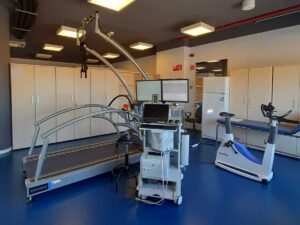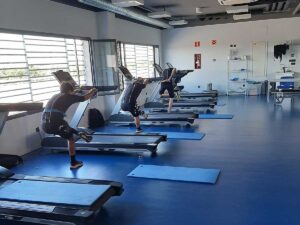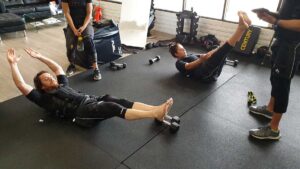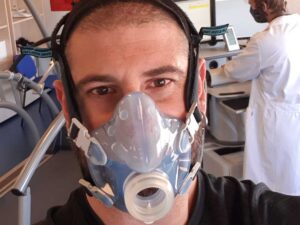Is it effective to train with medium-frequency devices?
There is a lot of uncertainty regarding electrostimulation’s use parameters and what type of parameters are the most effective. For example, if we focus on frequency, we see how, according to the electrostimulation system that we analyze, it is defended that it is better to use medium-frequency or low-frequency currents.
So much so that in some cases we can find affirmations about the superiority of the medium frequency for sports training with respect to low frequency. But is this true?
Before continuing and solving this question, we will explain some basic aspects:
1- Electrotherapy: physical therapy based on the application of controlled and safe electric currents to produce a positive effect on the organism. Normally these interventions aim to stimulate the nervous system, connective tissues and / muscle tissue.
Within the world of electrotherapy we can make a classification based on our electric wave frequency. In this way we can talk about:
– Low frequency: between 1Hz -1000 Hz (1 KHz)
– Medium frequency: 1 KHz- 10 (KHz) –
– High frequency: > 10 KHz
2- Frequency is the number of electric pulses emitted per second. Its unit of measurement is the Hz. Depending on the number of Hz selected, we can have a greater or lesser effect on one type of muscle or other fibers, and therefore, the training effect will be different. We usually use low-frequency currents within the training field, although some devices use medium frequencies. In no case is it recommended to use high frequencies or higher ranges of the average frequency during a workout.
Training with electrostimulation: medium or low frequency?
In this article, we will try to reach a clear conclusion regarding the six articles reviewed. These six articles conclude consensually that there is not much difference between the medium frequency and the low frequency. However, we can point out several issues with opting for one frequency or another.
One study mentions that low frequency causes less discomfort than medium frequency while some others show the opposite results. So, it seems the subjective perception of treatment comfort may vary between patients. Another article observes that low frequency produces less muscle fatigue than medium frequency.
Knowing this, we can think that low frequency is the most advantageous regarding comfort, strength, and muscular fatigue. Also, another article mentions that low frequency produces more muscle strength than medium frequency. Finally, analyzing all the above, we can conclude that low frequency is advantageous compared to medium frequency. Based on that, we have to consider our training objectives and make decisions based on common sense as physical exercise and sports science professionals. Medium and high frequency may create non-desired thermal effects and DNA damage, so the treatment dose should be precisely administrated.
In addition, we see how the frequency ranges most appropriate for muscle training are those of low frequency (<1000 Hz). Specifically, the 1-100 Hz frequency range has proven effective in sports training and can be applied to aerobic, strength, and resistance exercises.
To date, there is no evidence that medium-frequency devices offer any benefit over low-frequency devices. In many measured parameters, better results are obtained using low-frequency devices.
BIBLIOGRAPHY
- F. Medeiros, M. Bottaro, A. Vieira et. al. (2017). Kilohertz and Low-Frequency Electrical Stimulation With the Same Pulse Duration Have Similar Efficiency for Inducing Isometric Knee Extension Torque and Discomfort. American Journal of Physical Medicine and Rehabilitation. 96: 388-394.
- M. Vaz and V. Frasson. (2018). Low-Frequency Pulsed Current Versus Kilohertz-Frequency Alternating Current: A Scoping Literature Review. Archives of Physical Medicine and Rehabilitation. 99:792-805.
- H. Iijima, M. Takahashi, Y. Tashiro et al. (2018) Comparison of the effects of kilohertz- and low-frequency electric stimulations: A systematic review with meta-analysis Hirotaka. PLoS ONE. 13:1-19.
- Y. Laufer and M. Elboim. (2008) Effect of Burst Frequency and Duration of Kilohertz-Frequency Alternating Currents and of Low-Frequency Pulsed Currents on Strength of Contraction, Muscle Fatigue, and Perceived Discomfort. Physical Therapy. 8:1167-1176.
- W. Scott, J. Causey and T. Marshall. (2009). Comparison of Maximum Tolerated Muscle Torques Produced by 2 Pulse Durations. Physical Therapy. 89: 851-857.
- V. Da Silva., J. Durigan., R. Arena et al. (2015). Current evidence demonstrates similar effects of kilohertz-frequency and low-frequency current on quadriceps evoked torque and discomfort in healthy individuals: A systematic review with meta-analysis. Physiotherapy Theory and Practice. 31: 533-539.







